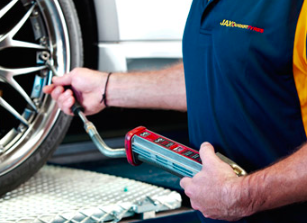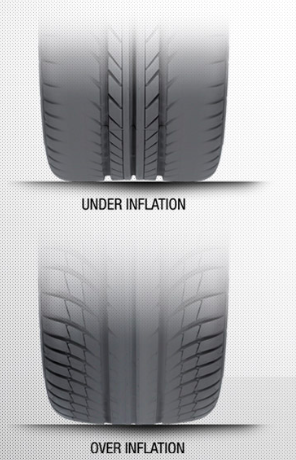
Did you realise that your car is literally riding on air? The pressure of the air inside your tyres is what supports the entire weight of your car! A tyre is a ring shaped covering that fits around your wheel rim.
It is in constant contact with the road and is made of absorbent materials so it can help absorb shock and provide grip. Pneumatic tyres are inflated with air, and the amount of air in a tyre can affect its performance dramatically. At JAX Tyres we strongly recommend that you check your vehicles tyre pressures regularly! (including the spare). Pressures should be checked cold, as there is an increase when the tyre has warmed up after being driven.
What is the recommended tyre pressure range for Australian vehicles?
The recommended tyre pressure range for Australian vehicles is typically between 30 to 35 PSI. It is crucial to maintain tyre pressure within this range to ensure optimal vehicle safety and performance. Incorrect PSI can lead to tyre damage and compromise your safety on the road. Regularly check and adjust your tyre pressure to keep it within the recommended range for a smoother and safer driving experience.
How much should you inflate your tyres?
All car manufacturers will have guidelines for the ideal inflation of your car’s tyres. This is usually expressed in terms of pressure, and most cars still have this information supplied in both metric and imperial, as do most air pumps at service stations. Your vehicle will have the correct tyre pressures displayed on a tyre placard. Be careful to read the fine print of the placard as most vehicle manufacturers recommend minimum tyre pressures. You will typically find the tyre placard either just inside the door, the filler cap or in the glove box. The vehicle manufacturer has designated the ideal tyre inflation based upon any conditions which the car is likely to face (number of passengers and load weight, for example), and maintaining this ideal pressure with regular checks will ensure you have the best ride and you will achieve the greatest longevity from your tyres.
But what happens if you over or under inflate your car’s tyres?
Over inflated tyres:
- Have a smaller contact patch with the road
- Will decrease rolling resistance and could therefore improve fuel consumption
- There may be an effect on braking
- Tyre wear may be greater in the centre of the contact area
- Compromise handling, ride comfort and tyre noise
Under inflated tyres
- Under inflated tyres have a greater contact area with the road
- This can increase rolling resistance and friction (the rubbing together of two moving objects) from tyre against road.
- Increased friction is bad for overall efficiency, and increases fuel consumption
- Can also create greater tyre wear and adversely affect performance. Increased friction causes tyres to get hotter, and the shape of under inflated tyres means that the shoulder of the tread wears faster
- Put extra stress on the casing and reduce tyre life
- Will adversely effect braking performance
Clearly checking tyre pressure and making sure it is at the recommended level is of benefit to your pocket and overall safety and driving enjoyment.
How often should you check tyre pressure?
Tyre pressures should be checked once a fortnight, or at a maximum at least once a month, when the tyres are cold (not having been run). Inflating your tyres with nitrogen will mean that you need to do so less often. If you select to inflate your tyres with nitrogen gas, JAX Tyres will inflate your tyres throughout their life without any additional charge. When nitrogen is used, top ups must always be with this gas to ensure the many benefits offered. Therefore, topping your tyres up with compressed air must be avoided.
Another important tip to remember is to never bleed pressures when the tyres are warm. It is dangerous to drive on under inflated tyres, as vehicle handling may be adversely effected, and excessive flexing and heat build-up may result in tyre failure.
The Advantages of a more stable tyre pressure include better grip, increased fuel economy and tyre life.
One of the best ways to achieve a more stable tyre pressure is through the JAX Tyres N27 Nitrogen Programme. Tyres may also be inflated with nitrogen rather than air, which is mostly nitrogen and about 20% oxygen. Air delivered from a compressor also contains moisture. Nitrogen gas is inert which offers greater protection to the tyre and permeates through its casing at a slower rate when compared with compressed air. This will ensure that your tyres retain the correct pressure for longer periods and as a consequence offer increased life. For more information on this service select the link below.
You won’t do it every time you fill up, but you may set aside a little extra time to do routine things like check the oil and water, and that would be a good time to also ensure your vehicles tyre pressure is right. With the correct pressure in your tyres you will experience the optimum levels of ride comfort and performance that your car is designed for. Anything that may adversely affect performance and safety should be taken seriously and correct tyre pressure very much falls into that category.
The Benefits of Correct Tyre Pressure

The most abused component on a motor vehicle is without doubt the tyre. And without proper maintenance, unnecessary and excessive tyre wear, as well as reduced fuel economy will be the result
To ensure you get the maximurn life from your tyres, it is imperative that you check the inflation pressures at least monthly or fortnightly if possible. This practice will deliver these costs and safety benefits:
- Maximise the tread life to the tyre's design potential
- Optimise vehicle handling in all road and weather conditions
- Safeguard fuel economy
- Maximise safety particularly when braking in an emergency
- Maximise ride comfort
Please click the links below for information regarding recommended tyre inflation pressures and over & under tyre inflation
Book in for a Vehicle Service at a JAX Tyres & Auto Near me!
There is no ‘right’ tyre inflation; it's dependent on several factors such as your
tyre type, vehicle, load and condition of the roads, to name a few. At Jax Tyres, we provide the best tyres and wheels for any kind of vehicle and brand.
All car manufacturers will have guidelines for the ideal inflation of your tyres. Your recommended tyre pressure can be found on a tyre placard or commonly listed on a sticker inside the driver door.
The vehicle manufacturer has decided on the ideal tyre inflation, based upon any conditions the car is likely to face. For example, the number of passengers and load weight. Don’t increase to the maximum pressure for your specific tyre, which can be found stamped onto the sidewall of your tyre.
Car tyre pressure is the measurement of how much air is in your tyre and ensures the tyres wear evenly and maintain the recommended level of grip on the road surface. This is expressed as pounds-per-square-inch (PSI).
The inflation pressure varies based on your specific tyre or vehicle. The tyre manufacturer will have a recommended tyre pressure based on these factors. These can be found in a tyre placard or commonly listed on a sticker inside the driver’s door.
There is no universal ‘best’ pressure. For harsher road surfaces, a lower pressure
with lower speed may be needed to avoid tyre damage. But, as the load increases, you will need to increase pressure.
The proper inflation is dependent on many factors:
- Type of vehicle
- Type of tyres
- Load
- How the vehicle is driven
- Condition of the road
While a lower tyre inflation is more dangerous, having an over inflated tyre can also be harmful, affecting the wear and tear of the tyres.
A higher inflated tyre is a lot stiffer and does not bend as much, which can cause it to be more susceptible to damage from debris or from rough terrain.
It will have less contact with the road, which does have the advantage of less friction. However, it will also cause increased tyre wear in the centre and a shorter lifespan negating any fuel economy this might have had.
If your vehicle’s tyres are underinflated it could lead to several problems,
including tyre failure:
- Tyre damage
- Improper vehicle handling
- Uneven tread wear
- Excessive heat build-up
You should also be aware that the load capacity of your tyres is reduced at lower pressures.
If your vehicle’s tyres are under-inflated by as little as 6 psi, it could lead to tyre damage.
Fast tyre wear: The shape of underinflated tyres leads to the tyres wearing more on the outside shoulders. It also puts extra stress on the casing to further reduce tyre life
Excessive heat build-up: Lower inflation pressure allows the tyre to flex more as it rolls. This increased friction causes internal heat to build up, which could lead to tyre failures
Increased fuel consumption: Low pressure increases friction and causes a reduction in fuel economy
Improper vehicle handling: You would also find a significant loss of steering precision and cornering stability
Overinflation may not seem harmful, but it can decrease the lifespan of the tyres even if your tyres are over-inflated by as little as 6 psi.
Damaged easily: they could be damaged more easily when driving over potholes or debris on the road.
Shortened tread life: Overinflation also causes tyres to wear in the centre of the tyre’s tread, which will reduce the tread life
Uncomfortable ride: Higher inflated tyres will also give you a much harsher ride.
Compromise handling: Improve fuel consumption: with a smaller contact area with the road, the rolling resistance will decrease and could therefore improve fuel consumption



